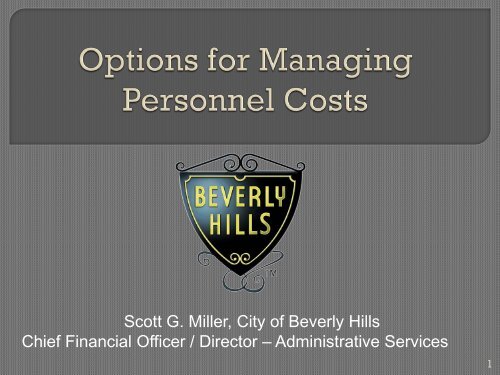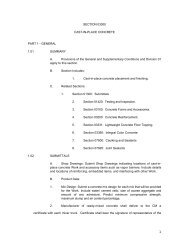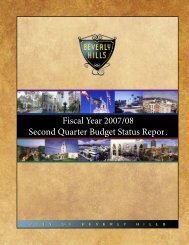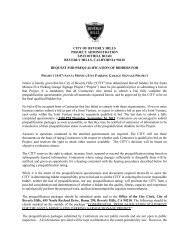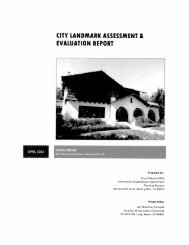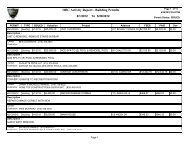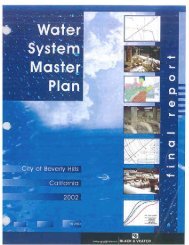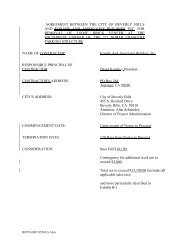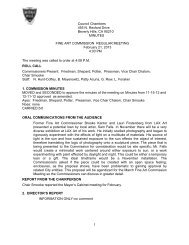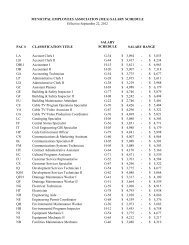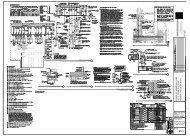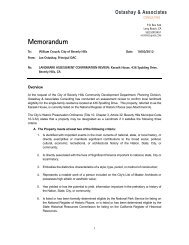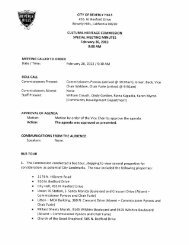ARMP Presentation - the City of Beverly Hills
ARMP Presentation - the City of Beverly Hills
ARMP Presentation - the City of Beverly Hills
You also want an ePaper? Increase the reach of your titles
YUMPU automatically turns print PDFs into web optimized ePapers that Google loves.
Scott G. Miller, <strong>City</strong> <strong>of</strong> <strong>Beverly</strong> <strong>Hills</strong><br />
Chief Financial Officer / Director – Administrative Services<br />
1
Implement Short, Mid and<br />
Long-Term Structural<br />
Changes to Reduce Employee<br />
Benefit Costs<br />
2
Program 1: Tied employee salary and benefit levels to <strong>the</strong> market<br />
as a total compensation model (Short-Term)<br />
• Projected savings <strong>of</strong> $730K - $2M over 5 years<br />
• Projected savings <strong>of</strong> $214M - $565M over 40 years<br />
Program 2: Implemented an expanded benefit cafeteria plan<br />
(Short-Term)<br />
• Projected savings <strong>of</strong> $2.1M - $4.8M over 5 years<br />
• Projected savings <strong>of</strong> $445M - $814M over 40 years<br />
Program 3: Alternative Retiree Medical Plan (<strong>ARMP</strong>) Phase I:<br />
Implemented a two-tier plan for new employee retiree health<br />
benefits (Short & Mid-Term)<br />
• Projected savings <strong>of</strong> $55.0M over 40 Years<br />
3
Program 4: Alternative Retiree Medical Plan (<strong>ARMP</strong>)<br />
Phase II: Implementing a defined contribution retiree<br />
health plan for current employees (Mid & Long Term)<br />
• Projected savings: $91 Million in unfunded liabilities<br />
Program 5: Developing a two-tier CalPERS employee<br />
retirement program for both Safety & Non-Safety<br />
personnel (Long-Term)<br />
• Projected savings: TBD<br />
4
Current Employees<br />
New Employees<br />
Compensation Tied to Market Rates<br />
and Total Compensation Model<br />
(Program 1)<br />
Compensation Tied to Market Rates<br />
and Total Compensation Model<br />
(Program 1)<br />
Cafeteria Health Plan (Program 2) Cafeteria Health Plan (Program 2)<br />
Choice <strong>of</strong> Current Retiree Medical<br />
Benefits or <strong>ARMP</strong> (Program 4)<br />
Defined Contribution Plan for Retiree<br />
Medical Plan (Program 3)<br />
Current CalPERS Retirement Plan<br />
(2.5% @ 55 – Miscellaneous;<br />
3% @ 50 – Public Safety)<br />
2 nd Tier CalPERS Retirement Plan<br />
(Program 5 – To be negotiated upon<br />
MOU renewals in 2011 & 2013)<br />
5
$800,000,000<br />
$700,000,000<br />
Projected 40-Year Savings (Programs 1-4) for Non Safety<br />
Employees<br />
$714,000,000<br />
$600,000,000<br />
$500,000,000<br />
$445,000,000<br />
$400,000,000<br />
$300,000,000<br />
$214,000,000<br />
$200,000,000<br />
$100,000,000<br />
$55,000,000<br />
$91,000,000<br />
$-<br />
Program 1:<br />
Tie Salary &<br />
Benefit Levels to<br />
Market<br />
Program 2:<br />
Cafeteria Plan<br />
Program 3:<br />
Defined<br />
Contribution Plan<br />
for New Hires<br />
Total Projected 40<br />
Year Savings For<br />
All Four Programs<br />
Projected 40 Year<br />
OPEB Liability<br />
Savings<br />
6
Employing salary and benefit surveys <strong>of</strong><br />
comparable cities, <strong>the</strong> <strong>City</strong> <strong>of</strong> <strong>Beverly</strong> <strong>Hills</strong> tied<br />
employee compensation to market levels<br />
• Assures employees that <strong>the</strong>y are at least at <strong>the</strong> 75 th percentile <strong>of</strong><br />
salary and benefits in <strong>the</strong> area<br />
• Enables <strong>the</strong> <strong>City</strong> to more accurately plan for salary and benefit<br />
related expenses<br />
• Provides a quantitative basis for salary and benefits levels<br />
during negotiations<br />
7
The <strong>City</strong> implemented a Cafeteria Plan that<br />
capped contribution limits and allowed<br />
employees to ei<strong>the</strong>r opt out or choose from a<br />
variety <strong>of</strong> healthcare plans<br />
• The Cafeteria Plan gives employees <strong>the</strong> option to choose from<br />
multiple vision, dental and medical PPO and HMO plans<br />
• Employees benefit if <strong>the</strong>y choose lower cost plans or opt out<br />
completely by having a portion <strong>of</strong> <strong>the</strong> savings passed on to<br />
<strong>the</strong>m as a cash payment<br />
•<br />
• The <strong>City</strong> benefits from a cap on <strong>the</strong> gross amount <strong>of</strong> insurance<br />
costs and savings from employees who pick less costly plans<br />
8
$106,000,000<br />
Program 2: Cost <strong>of</strong> Employee Health Care Benefits<br />
$96,000,000<br />
$86,000,000<br />
Add graph<br />
$76,000,000<br />
$66,000,000<br />
$56,000,000<br />
$46,000,000<br />
$36,000,000<br />
$26,000,000<br />
$16,000,000<br />
$6,000,000<br />
2010<br />
2011<br />
2012<br />
2013<br />
2014<br />
2015<br />
2016<br />
2017<br />
2018<br />
2019<br />
2020<br />
2021<br />
2022<br />
2023<br />
2024<br />
2025<br />
2026<br />
2027<br />
2028<br />
2029<br />
2030<br />
2031<br />
2032<br />
2033<br />
2034<br />
2035<br />
2036<br />
2037<br />
2038<br />
2039<br />
2040<br />
2041<br />
2042<br />
2043<br />
2044<br />
2045<br />
2046<br />
2047<br />
2048<br />
2049<br />
Projected Health Benefit Costs Without Cafeteria Plan (Based on Historical 6.5% Increase)<br />
Projected Health Benefit Costs With Current Cafeteria Plan (<strong>City</strong> Council Increases Benefit Level by 5% Annually)<br />
Projected Health Benefit Costs With Current Cafeteria Plan (<strong>City</strong> Council Increases Benefit Level by 3% Annually) 9
The <strong>City</strong> instituted a defined contribution retiree<br />
health plan to replace <strong>the</strong> prior defined benefit<br />
plan. This applied to all employees hired after<br />
January 1, 2010.<br />
• Caps <strong>the</strong> cost <strong>of</strong> future retiree medical benefits for new nonsafety<br />
employees<br />
• Eliminates OPEB unfunded liabilities for new employees<br />
• As a defined contribution plan it is portable and transferrable;<br />
does not require employee to retire with <strong>the</strong> <strong>City</strong><br />
• Still provides a generous retiree health plan benefit that is<br />
geared to younger workers<br />
10
The <strong>ARMP</strong> is a voluntary option that allows current<br />
employees to choose a defined contribution retiree<br />
medical plan in lieu <strong>of</strong> a defined benefit plan.<br />
11
Current Defined Benefit vs. Defined Contribution:<br />
Current employees hired before January 1, 2010 are provided a<br />
certain level <strong>of</strong> retiree medical coverage as defined in <strong>the</strong>ir MOU<br />
but <strong>the</strong> use <strong>of</strong> <strong>the</strong>se plans is heavily restricted and is non<br />
transferrable.<br />
• The <strong>ARMP</strong> allows employees to receive <strong>the</strong> net present<br />
actuarial value <strong>of</strong> <strong>the</strong>ir current retiree benefit now, instead <strong>of</strong><br />
waiting until <strong>the</strong>y retire<br />
• Employees get a one-time transition amount which is<br />
actuarially determined and a residual monthly amount into an<br />
RHS account if not fully vested<br />
• Amounts are specific to each employee<br />
12
The Choice<br />
Current Retiree or Alternative<br />
Medical Benefit<br />
Retiree Medical<br />
(Defined Benefit)<br />
Program (<strong>ARMP</strong>)<br />
(Defined Contribution)<br />
13
Benefits to <strong>the</strong> <strong>City</strong><br />
Reduces <strong>the</strong> <strong>City</strong>’s current OPEB<br />
unfunded liability by a projected $91<br />
million dollars over 40 years with<br />
58% participation<br />
Allows <strong>the</strong> <strong>City</strong> to cap <strong>the</strong> costs <strong>of</strong> <strong>the</strong><br />
retiree health program instead <strong>of</strong><br />
being at <strong>the</strong> mercy <strong>of</strong> Cal-PERS and<br />
future health care costs increases<br />
Benefits to <strong>the</strong> Employee<br />
Gives participating employees <strong>the</strong><br />
option <strong>of</strong> receiving lump sum amount<br />
in cash, a deferred compensation<br />
plan, or a combination <strong>of</strong> <strong>the</strong> two for<br />
maximum flexibility<br />
Allows portability <strong>of</strong> <strong>the</strong> defined<br />
contribution: employee can take <strong>the</strong><br />
benefit with <strong>the</strong>m even if <strong>the</strong>y decide<br />
to separate from <strong>the</strong> city<br />
15
Benefits to <strong>the</strong> <strong>City</strong><br />
Keeps employee benefits highly<br />
competitive which aids recruitment<br />
and retention<br />
Benefits to <strong>the</strong> Employee<br />
Builds trust by allowing employees to<br />
positively affect <strong>the</strong> <strong>City</strong>’s fiscal health<br />
while benefiting at <strong>the</strong> same time<br />
Substitutes low cost bonded dollars<br />
for high cost future dollars, thus<br />
capping <strong>the</strong> <strong>City</strong>’s costs & lowering<br />
OPEB unfunded liability<br />
Provides a voluntary alternative to<br />
employees current retiree medical<br />
benefit<br />
16
Impact <strong>of</strong> <strong>ARMP</strong> (Safety & Non-Safety) on Projected<br />
Unfunded Accrued Liability Over 40 Years<br />
$400,000,000<br />
$350,000,000<br />
$217,000,000<br />
$300,000,000<br />
$250,000,000<br />
$200,000,000<br />
$150,000,000<br />
$100,000,000<br />
$50,000,000<br />
$-<br />
$157,000,000<br />
Past <strong>City</strong> Program (Pay As You Go)<br />
$109,000,000<br />
$66,000,000<br />
50% <strong>of</strong> Current Safety & 58% <strong>of</strong> Non-Safety<br />
Employees Electing to Convert to a Defined<br />
Contribution Plan<br />
Police & Fire (Safety)<br />
Non-Safety<br />
17
Results and Follow up <strong>of</strong> <strong>the</strong> <strong>ARMP</strong>:<br />
• 58% participation from eligible participants<br />
• Generated interest from <strong>the</strong> Police and Fire<br />
departments; looking ahead to a second<br />
<strong>of</strong>fering for Safety employees<br />
18
• Plan to implement a two-tier pension plan for<br />
all Public Safety and Miscellaneous employees<br />
• Proactive step in tackling <strong>the</strong> runaway issue <strong>of</strong><br />
pension costs: actuarial analysis show that CalPERS<br />
pension plans are unsustainable 1<br />
• Does not affect current employees or impinge on<br />
negotiated benefits<br />
• Allows <strong>the</strong> <strong>City</strong> to keep in line with an increasing<br />
number <strong>of</strong> municipalities instituting two tier plans<br />
1<br />
Ron Seeling, Chief Actuary at CalPERS<br />
19
Marcus Wu<br />
Partner<br />
Hanson Bridgett LLP
Vested-rights law under California<br />
Constitution<br />
Exposure to current taxation (e.g.,<br />
constructive receipt, assignment <strong>of</strong><br />
income, cash-or-deferred arrangement<br />
(CODA))<br />
Tax limits on deferred contributions (e.g.<br />
401k and 457b plans)<br />
Overcoming <strong>the</strong> obstacles<br />
21
Informed consent<br />
Full and free choice between benefit<br />
programs<br />
Shifting legal landscape<br />
22
Structured as choice between programs<br />
Vesting period for cash-outs<br />
Mandatory 20% RHS contribution<br />
Program funded by employer<br />
contributions only; no salary reductions<br />
Election converted nontaxable benefits<br />
to taxable, not vice versa<br />
23
<strong>ARMP</strong> structured as employer<br />
contributions<br />
Enabled 401k plan to use higher 415(c)<br />
limit<br />
415(m) excess-benefit plan for overflow<br />
(<strong>City</strong> used ICMA-RC design)<br />
24
Not risk-free, but risk can be managed<br />
Balance against long-term economic<br />
value<br />
Possibly lower risk given current<br />
economic conditions<br />
Don’t try this at home alone<br />
25
Cash-out option under cafeteria plan<br />
Cost-saving opportunity with cash<br />
<strong>of</strong>fering<br />
If in PEMHCA, employer must still make<br />
minimum contributions<br />
26
Brad Au<br />
Senior Vice President<br />
Aon Hewitt
“Cost neutral” or better – cost avoidance<br />
Cap <strong>the</strong> <strong>City</strong>’s future medical cost<br />
increases<br />
Supportable / “reasonable” assumptions<br />
Fair / attractive to employees<br />
28
Existing retiree healthcare program description<br />
• CalPERS health program<br />
• 10 bargaining groups, each w/ tiered benefit structures<br />
• Fixed dollar benefits and varying premium coverage<br />
<br />
<strong>ARMP</strong> - employee option to convert Defined Benefit (DB) to Defined<br />
Contribution (DC)<br />
<br />
Initial account balance = DB retiree healthcare “accrued liability”<br />
• GASB 45: FYE 2009 - $58 MM (roughly 50% eligible for <strong>ARMP</strong>; non-safety)<br />
<br />
“Residual” payments<br />
• DC annual allocations add to account balance<br />
• Paid for duration <strong>of</strong> DB “accrual” or “funding” period<br />
• Based on annual cost to provide DB plan<br />
29
Defined Benefit<br />
(DB) Plan<br />
Versus<br />
Defined Contribution<br />
(DC) Plan<br />
Variable Cost Fixed<br />
Known<br />
Level <strong>of</strong> Healthcare<br />
Coverage<br />
Unknown<br />
Retirement/Non-<br />
Portable<br />
Eligibility Termination/Portable<br />
<strong>City</strong> Who Takes Risk Employee<br />
Interpretation <strong>of</strong> Plan Provisions<br />
• Vesting vs. accrued<br />
• Benefit accrual period<br />
• Targeted benefit<br />
Projection <strong>of</strong> Results<br />
• GASB 45 OPEB results<br />
• Unfunded liability<br />
• Cash flow / financing<br />
• Sensitivity to assumption variability<br />
30
Supportable, equitable, communicable, sellable<br />
• GASB OPEB where possible / practicable - valuation vs. individual<br />
calculations<br />
• Considered historical – investment returns, trend, retirement<br />
• CalPERS assumptions<br />
• No single “right” answer<br />
<br />
<br />
Types <strong>of</strong> assumptions<br />
• General – discount rate / investment return, healthcare trend, mortality,<br />
full/partial value<br />
• Bargaining group – retirement age, accrual period<br />
• Individual – plan election, marital, spousal age difference, gender<br />
Impact <strong>of</strong> assumptions<br />
• Understand what’s important<br />
• Drivers <strong>of</strong> costs, benefits, emotions<br />
• Many have considerable (e.g., 50%+) impact on results<br />
31
Numerous assumption sets<br />
• Start w/ GASB OPEB valuation assumptions<br />
• 15+ versions…w/ a, b, c scenarios<br />
• Conservative vs. “reasonable” vs. aggressive<br />
Final assumptions<br />
• 6% investment return (<strong>City</strong>’s historical return: 9.8%),<br />
10% to 5% trend, full value <strong>of</strong> accrued liability<br />
• Retirement ages 52 to 63, primarily 20 year accrual /<br />
“funding”<br />
• Most valuable benefit election, same age spouse,<br />
gender neutral<br />
32
General Process<br />
1) Set goals<br />
2) Understand provisions (e.g., MOU, o<strong>the</strong>r communication)<br />
3) Establish assumptions<br />
4) Preliminary results<br />
5) Review / modify assumptions<br />
6) Review / interpret MOUs<br />
7) Revise results and reassess<br />
8) Repeat steps 5-8 as many times as necessary<br />
Methodology is important<br />
• 10 bargaining groups, tiered benefit structures, MOU vs. administrative<br />
practice<br />
Valuation vs. individual considerations<br />
• Calculations are different, e.g., we don’t all die at <strong>the</strong> same age…<br />
Need to Educate<br />
• <strong>City</strong> Council, <strong>City</strong> Manager, Finance, HR, actuary / consultant,<br />
bargaining units, individual employees<br />
33
John Kim<br />
Partner<br />
De La Rosa & Company
Two options for funding <strong>the</strong> <strong>ARMP</strong> prepayment<br />
amount:<br />
• Cash<br />
• Borrow money<br />
• Taxable conventional bank financing (i.e. line <strong>of</strong><br />
credit)<br />
• Taxable municipal bond financing (i.e. lease revenue<br />
bonds)<br />
The <strong>City</strong> went out to bid to several commercial<br />
banks and its bond underwriter to select <strong>the</strong><br />
lowest cost <strong>of</strong> borrowing<br />
35
Cash<br />
Pros<br />
• No interest cost<br />
• Ease <strong>of</strong> execution<br />
• Ability to size funding <strong>of</strong> <strong>ARMP</strong><br />
prepayments<br />
Cons<br />
• Decreased reserves/liquidity<br />
Conventional<br />
Bank Loan<br />
• Low interest cost<br />
• Maintains reserves/liquidity<br />
• Ability to size funding <strong>of</strong> <strong>ARMP</strong><br />
prepayments<br />
• Interest cost<br />
• Need to pledge security<br />
(collateral)<br />
• 60-90 days required<br />
Municipal<br />
Bonds<br />
• Lowest interest cost<br />
• Maintains reserves/liquidity<br />
• Interest cost<br />
• Need to pledge security (typically<br />
leased asset)<br />
• 60-90 days required<br />
• Less flexibility to size funding <strong>of</strong><br />
<strong>ARMP</strong> prepayments<br />
36
The <strong>City</strong> selected<br />
municipal bond<br />
financing based on<br />
<strong>the</strong> lower cost <strong>of</strong><br />
borrowing vs. bank<br />
line <strong>of</strong> credit<br />
(0.73% lower)<br />
Saved over $900,000<br />
over 11 years, on top<br />
<strong>of</strong> <strong>the</strong> long-term<br />
savings for all 4<br />
programs<br />
CITY OF BEVERLY HILLS<br />
CNB Bank Loan vs. Taxable Bond Financing (11 Year Maturity)<br />
CNB Loan Payments 2010 Bond Payments<br />
Annual<br />
Date Annual Date Annual Savings<br />
7/31/2011 2,388,312 6/1/2011 2,299,827 88,485<br />
7/31/2012 2,388,312 6/1/2012 2,302,348 85,963<br />
7/31/2013 2,388,312 6/1/2013 2,300,573 87,738<br />
7/31/2014 2,388,312 6/1/2014 2,299,516 88,796<br />
7/31/2015 2,388,312 6/1/2015 2,298,411 89,900<br />
7/31/2016 2,388,312 6/1/2016 2,301,893 86,419<br />
7/31/2017 2,388,312 6/1/2017 2,299,872 88,440<br />
7/31/2018 2,388,312 6/1/2018 2,297,477 90,835<br />
7/31/2019 2,388,312 6/1/2019 2,298,915 89,397<br />
7/31/2020 2,388,312 6/1/2020 2,299,667 88,644<br />
7/31/2021 2,388,312 6/1/2021 2,299,669 88,643<br />
Total Payments 26,271,427 25,298,168 973,259<br />
Avg Annual Payment 2,388,312 2,299,833 88,478<br />
Total Proceeds 20,000,000 20,000,000<br />
10-Year Treasury 3.03% 3.03%<br />
Spread to Treasury +1.99% +1.26%<br />
All-In Interest Rate 5.02% 4.29%<br />
(Includes Costs <strong>of</strong> Issuance)<br />
37
The <strong>City</strong> issued taxable lease revenue bonds secured<br />
by General Fund lease payment<br />
• Utilized unencumbered leased asset (i.e. Rodeo Drive parking<br />
facility)<br />
• Bonds are taxable because proceeds will be used to fund pre-fund<br />
private retiree benefits<br />
Term <strong>of</strong> <strong>the</strong> bonds: 11 years<br />
Strong underlying credit ratings (“Aaa/AAA/AAA”)<br />
• No debt service reserve fund<br />
• Overall taxable yield: 4.53%<br />
The <strong>City</strong> adopted fiscal policies giving <strong>Beverly</strong> <strong>Hills</strong><br />
residents/investors first priority to purchase bonds<br />
• <strong>City</strong>-hosted website: www.buybeverlyhillsbonds.org<br />
• Bonds sold out in 53 minutes!<br />
38
Educate your elected <strong>of</strong>ficials on funding options early<br />
Develop matrix to compare funding options<br />
• Reserves/liquidity<br />
• Interest/upfront costs<br />
• Flexibility to size prepayment amount<br />
• Security needed (i.e. collateral and/or revenue pledge)<br />
• Timing<br />
If conventional bank financing used, consider:<br />
• What collateral (e.g. segregated cash deposit, land)<br />
If municipal bonds are used:<br />
• What is my agency’s credit rating<br />
• Do I have leased assets available<br />
39
Over 29 years experience in both public and private sectors<br />
Has worked in a management capacity for <strong>the</strong> <strong>City</strong> <strong>of</strong><br />
Claremont, <strong>City</strong> & County <strong>of</strong> San Francisco, Turner<br />
Broadcast, Delloitte/Tousche and <strong>the</strong> <strong>City</strong> <strong>of</strong> Palm Desert,<br />
among o<strong>the</strong>rs<br />
Recipient <strong>of</strong> commendations from <strong>the</strong> State <strong>of</strong> California, <strong>the</strong><br />
CSU system, <strong>the</strong> Municipal Management Assistants <strong>of</strong><br />
Sou<strong>the</strong>rn California, <strong>the</strong> Municipal Information Systems<br />
Association <strong>of</strong> CA, <strong>the</strong> Government Finance Officers<br />
Association<br />
Presented to ICMA, GFOA, State <strong>of</strong> California, CSMFO and<br />
National Association <strong>of</strong> Colleges & Universities.<br />
Phone: (310) 285-2411<br />
Email: sgmiller@beverlyhills.org<br />
42
Senior Vice President and actuary in Aon Hewitt’s Los<br />
Angeles <strong>of</strong>fice.<br />
Over 15 years <strong>of</strong> experience consulting on various<br />
employee benefit and retirement programs.<br />
Assists senior management in <strong>the</strong> strategy and design <strong>of</strong><br />
retirement programs that meet organizational goals.<br />
Experience in <strong>the</strong> public and private sector includes<br />
advising on pension, retiree medical, supplemental<br />
retirement, and o<strong>the</strong>r benefit programs<br />
Phone: (213) 996-1729<br />
Email: brad.au@aonhewitt.com<br />
43
Partner based in Hanson Bridgett’s San Francisco Office<br />
Specialist in representing public and private employers<br />
with respect to compensation and benefits matters with<br />
a focus on retirement and deferred compensation,<br />
particularly 401(k) plans and ESOPs<br />
Experienced in helping to establish and administer<br />
health plans, flexible benefit plans, dependant care<br />
plans, and a wide range <strong>of</strong> severance benefit plans<br />
Phone: (415) 995-5829<br />
Email: mwu@hansonbridgett.com<br />
44
De La Rosa & Co. is a top-five ranked bond<br />
underwriter serving California public agencies<br />
Partner based in Los Angeles Office<br />
Over 14 years <strong>of</strong> experience working with<br />
cities, counties, special districts and o<strong>the</strong>r<br />
public agencies<br />
Specializes in bond financing for public<br />
infrastructure, utilities, redevelopment, schools,<br />
and housing<br />
Phone: (310) 207-1975<br />
Email: jkim@ejdelarosa.com<br />
45


